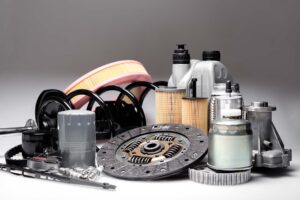If you’re like most people, you rarely think about your car’s headlights until something goes wrong. But when one of them starts to look dim, it can be a hard thing to ignore, and then it’s time to quickly figure out how to fix dim headlights. With the right guidance, some handy supplies, and a few minutes of free time, you will have your headlights shining brightly again in no time! Here’s the ultimate guide to doing so.
What Are the Causes of Dim Headlights?
No matter if you own a brand-new car, a used vehicle, or even one with a salvage title, there’s a wide variety of factors that are at play when it comes to the brightness of your headlights. Here are the most common culprits behind them losing their glow:
Low Voltage
Probably the most common cause of dim headlights is low voltage. To properly function at full brightness, they require a certain amount of voltage, and if it’s too low, the headlights might appear dim. This can happen for a variety of reasons, including a weak car battery, a faulty alternator, or a damaged electrical system.
In some cases, a low voltage may also be caused by the use of low-quality or incompatible headlight bulbs. It’s important to address low voltage promptly, as it can impact not only their brightness but also the overall performance of other electrical components.
Corroded Connections
Another common cause of headlights losing their brightness is corroded electrical connections. If this occurs, the corroded connections can restrict the flow of electricity to the bulbs, resulting in dim headlights. Corrosion can occur due to exposure to moisture or other environmental factors, as well as poor maintenance or neglect.
Worn-Out Bulbs
As the headlight bulbs age and are exposed to heat and vibration, their filaments can become weakened or damaged, resulting in decreased brightness. In addition to reduced brightness, worn-out bulbs may also emit a yellowish or hazy light, making it more difficult to see the road ahead while driving at night.
Dirty Lenses
Over time, the lenses can become dirty or foggy, reducing the amount of light that can pass through, resulting in decreased brightness. Dirt, debris, and other environmental factors can contribute to this, and, in addition to losing brightness, these elements can cause the light to scatter. That can be incredibly dangerous, especially when cruising down the most famous routes in the US during the night.
Alternator Issues
The alternator is responsible for generating electrical power and charging the car battery while it’s running. If this part is not functioning properly, it may not be able to provide enough power to the headlights, and that results in decreased brightness. This can happen if the alternator is damaged, the belt is worn-out, or the voltage regulator becomes faulty.
How to Diagnose Dim Headlights
Identifying the underlying cause of the issue is not so difficult – all you need to do is check the common causes of dim headlights we just went over. However, if you’re still not sure what’s the culprit behind your dimmed view of the road, you can always consult with your local mechanic. Maybe it’s time for the general check-up anyway, so it’ll be the best course of action.
Check Voltage and Electrical Connections
If you’re intent on dealing with the problem yourself, the first thing you should check is the voltage and the condition of the electrical connections. Simply use the multimeter to see if the voltage is too low, and then move on to the electrical connections and thoroughly look them over for any signs of corrosion, looseness, or damage.
Examine the Headlight Bulbs
As already mentioned, headlight bulbs can become worn out or damaged over time, so it’s a very common cause of reduced brightness. Visually inspect the bulbs to see if there are any signs of damage, discoloration, or wear and tear. If everything appears to be in good condition on the outside, it’s time to use a multimeter and check the bulb’s filament.
Inspect the Lenses
Aside from having faulty or damaged bulbs, headlights can become dirty or foggy, so it’s also important to check if there are any signs of dirt, debris, or discoloration that might be obscuring your view. Obviously, this is the best-case scenario – all you need is some soapy water and a sponge to overcome this problem.
Check the Alternator
As mentioned, a faulty alternator can result in a decrease in generated power, which reduces the brightness of your headlights. Simply checking the voltage output of the alternator will tell you if it’s not working as it should. It is also important to check the alternator belt for signs of damage or wear and tear.
This might be the worst-case scenario, but only for one reason – it most probably isn’t something you can deal with yourself, and taking your four-wheeler to a qualified mechanic might be your only solution to the problem.

What Are the Materials Needed to Fix Dim Headlights?
The materials that should be used to fix this problem depend on the underlying cause of the issue. Here’s an overview of the most common scenarios with their adjacent remedies and materials:
| Problem | Needed Materials |
| Bulbs are worn out or damaged | A high-quality replacement |
| Electrical connections are corroded or too loose | Vinegar or other cleaning solutions and a cable-tightening tool |
| Lenses are dirty or foggy | Soapy water or a specialized headlight restoration kit |
| The alternator is faulty | Replacement components, a new alternator, or a new voltage regulator |
How to Fix Dim Headlights – A Step-By-Step Guide
When it comes to any problem, from fixing the clutch master cylinder to replacing your windshield wipers, the first part of the whole ordeal is to figure out what the underlying cause is. The same goes for fixing your low-brightness headlights – once you know what the culprit is, you’ll know how to address the problem accordingly.
Replace Headlight Bulbs
If the bulbs are showing signs of wear and tear, it’s time to replace them with high-quality, compatible replacements. I recommend getting the SEALIGHT H11/H8/H9/H16 LED Bulbs, as from personal experience, they will last you a long time, and they can be installed on most vehicles.
However, there are plenty of options, LED or not, so do your research thoroughly, and you’ll surely end up with a pair that will brighten the road for years to come. It’s also important that you know the type and size of your existing bulbs, as it will help you narrow down your search. While you’re at it, maybe it’s time to change the tail lights as well.
If you’re not sure how to fix dim LED headlights (or regular bulbs, for that matter), here are the steps you need to take in order to replace the old bulbs with a new, quality pair:
- Locate the headlight assembly on your vehicle,
- Remove the cover to access the bulb,
- Remove the wiring harness,
- Twist the old bulb counterclockwise until it’s removed from the socket,
- Insert the new bulb into the socket and twist it clockwise until secure,
- Reconnect the wiring harness,
- Test if everything is working properly.
Clean Headlight Lenses
As I’ve already mentioned, the best-case scenario is that the reason behind your dimmed headlights is dirty lenses. That’s because the problem can be solved in only a few minutes by simply cleaning the lenses with some soapy water and a soft cloth until there are no more traces of dirt or debris.
To those that are interested in thoroughly cleaning their headlights and adding a protective layer for durability, I would recommend buying a specialized headlight restoration kit. In my opinion, the best one on the market right now is the CERAKOTE Ceramic Headlight Restoration Kit. With this product, your lenses will be cleaned, cleared, and polished in just a matter of minutes.

Fix Electrical Connections
If the reason why you don’t have a good, bright view of the road ahead is a problem with electrical connections, here are the steps to fix them:
- Identify the connections that have corrosion or are too loose,
- Use a specialized electrical contact cleaner to remove dirt and corrosion,
- Use a wire brush or emery cloth to gently scrub any remnants,
- Tighten the connection securely,
- Repeat the process for any other problematic connections.
Alternator Repair or Replacement
Changing an alternator by yourself is something that only the most dedicated gearheads out there can manage. That’s why it’s best to take it to a qualified mechanic to get it repaired or replaced. Depending on the problem, you might end up with a new voltage regulator or alternator belt, and in some cases, a whole new alternator will be installed.
While a high-quality, compatible replacement might add a significant amount to your overall cost of owning a car, it’s important to make a good investment to ensure that everything will function properly for years to come. The road ahead will be brighter than it ever has been!

Are There Some Alternative Methods for Fixing Dim Headlights?
When it comes to dealing with dirt or debris accumulated on your lenses, there are numerous alternative methods that will make this part of your vehicle nice and clean. Toothpaste, baking soda, and other supplies found in your home can be great at getting rid of the debris obscuring the view. However, these methods won’t address the underlying electrical or mechanical issues – these problems can be fixed only with the steps mentioned above.

How to Prevent Dim Headlights
Headlights, like everything else, are prone to general wear and tear. So, while there’s no way to ensure that the electronics in your vehicle function properly forever, there are ways to prolong their lifespan. Here are the most important tips for keeping your headlights working for as long as possible:
Regular Maintenance
Regular maintenance is of utmost importance for keeping your vehicle and all of its parts in optimal condition. Having regular check-ups, cleaning the lenses often, and inspecting the electrical connections once in a while can go a long way in keeping not only the headlights in order but other parts of your four-wheeler as well.
Replace Bulbs Before They Burn Out
An effective proactive approach to preventing dim headlights is to replace the bulbs before they burn out. Bulbs tend to gradually lose their brightness over time, which can make it difficult to notice when it’s becoming a serious problem. Regularly replacing the bulbs, such as every year or every two years, can ensure that they will always operate at full brightness and visibility.
Keep Lenses Clean
Last but not least, it’s important to keep the headlights on your four-wheeler nice and clean. It will prevent them from becoming dirty or foggy and increase the amount of light that is passing through. By investing only a few minutes of your time every other week, you are ensuring that the headlights will operate at their full brightness and optimal visibility.
Now That You Know How to Fix the Problem, You Can Enjoy the Bright Road Ahead for Years to Come
Whether your headlights are dim or dull, fixing them is the only sure way to brighten up the dark roads ahead. Now that you know the most common scenarios and ways to deal with each problem, you can take a stab at fixing your car’s headlights on your own – you might just end up surprising yourself with what can be accomplished with just a bit of time and effort. Good luck with keeping the lights bright!








